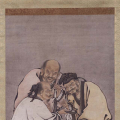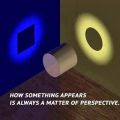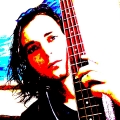Welcome home! Please contact lincoln@icrontic.com if you have any difficulty logging in or using the site. New registrations must be manually approved which may take several days. Can't log in? Try clearing your browser's cookies.
Drop in the ocean?
 Jeffrey
Veteran
Jeffrey
Veteran





Comments
The absolute reality show casing itself as the relative.
One step towards experience liberates everything including self and other.
Each instant of pure experience, beyond time and space.
Can we hear the truth body as the truth body?
Indra's net automatically implies the voidness of everything.
Ultimately a symbol such as a poem reflects one's definite realization.
The difference is that the words of those poets are inspiring to some and that is positive and creative. Your words above hold no more actual truth than theirs, but are of a negative nature.
Can't you see that they might be viewed that way?
A Buddha can see both the relative and absolute simultaneously.
For instance a Buddha can see a flower as both appearance and emptiness.
A flower is all causes and conditions of the whole infinite universe arising in that effect of flower, thus void.
The poets describe it in such positive language, such as "buddha nature".
Whereas others describe it in such negative language.
Both affirming the same thing if realized, but if conceptualized a poison one drinks.
An instant is samsara to those with dualistic vision.
To those who recognize the real meaning then an instant contains everything, thus void. The sound contains all sounds, hallow, empty, unborn, neither coming nor going, yet completely unceasing.
Interdependence and emptiness are two sides of the same coin.
Maybe we are speaking past each other?
What are "they" without the aggregates?
How did you answer my post? I don't understand.
Are you saying that poetry is evil? Seems kinda weird.
A drop may not be a drop but that is what we call it in order to split the subject from the object. Seems to be a necessary function in discovery and the sharing of differing perspectives.
That drop isn't just the ocean... It is the clouds too. And every tiny speck of moisture following the path of least resistence. That drop is 90% or so of our atomic structure.
We are. That is not the illusion. That we are seperate, that's the illusion.
But that is where you and I will probably always disagree. Either way if one has an eternalistic view of the Mind that too is beautiful and worth veneration.
But that is where you and I will probably always disagree. Either way if one has an eternalistic view of the Mind that too is beautiful and worth veneration.
Songhill's view is not eternalistic because time is relative and the three times are only pointers to the present experience including memory. Without time there can be no eternity unless you mean 'eternity' as sort of a provisional and poetic turn of phrase.
When one sees the absolute or pure Mind, yes, there are phenomena still present (like your drop and the ocean), but they are illusory; they are nothing in themselves; nothing above or greater than the substance, pure Mind, from which they are composed.
But we must becareful not to establish anything as having any sense of ontological reality, including dharmakaya. We negate what we affirm, until there is nothing to negate, then that negation is also negated till there is no more ground.
If we make this groundless ground into something, well that would propagate the original ignorance of perception ahahha.
anyways here is a quote that I personally enjoy:
"When the doors of perception are cleansed, everything appears to the mind as it is - INFINITE."
-William Blake
The way to tell is if the Buddha qualities of love and wisdom are manifesting. And how can one know that? One could be deluded so it is quite tricky?
But when prapancha ceases the Buddha qualities emerge. The wind of suffering can be harnassed to propel the boat in the right direction. A meeting with the universe. That's how you tell, I suppose. If you are suffering more and more that could be an opportunity. I think meditation is like a means of clearing up so that you can notice things. Just thinking.
In Dzogchen there is a saying:
Trust your experience, but keep refining the view.
Use both as if the real meaning is intuited then there really is no problem between the two.
Either way I am in agreement.
If a shared delusion is universal then it is still reality while in the dualistic state. I know I seem to be pretty nit picky (and perhaps short sighted at times) for someone that is non-sectarian but compassion is a big deal and it can become just a figurehead if the common sense of it is taken away.
To say that it is all just illusion seems to negate the first Noble Truth...
I'm far from informed in these matters but I know what is taught in TB and its madhyamika and not cittimatra.
We are finding this in our own experience and meditation. It's not something (I think) that appears around the bend. Already here. It's the realization that 'we really mean it'. It is here. We really mean it; there is clinging and a direction of ceasing.
But maybe you can say that's a view. 'If I know what You mean?'
So we have no view but we consider it a view. ::snap:: "SHIT!"
And neither and back again.
@person
Nagarjuna, scholar-rockstar!
at-everyone:
I actually really like the way this thread is flowing.
Would anyone like to comment on Buddha teaching the Dharma in three turnings? I feel like that is especially relevant.
Let raindrops be raindrops and oceans be oceans.
The aperture opens up and we start to notice other people. We don't even stop the Hinayana path of refuge and meditation. This is an ongoing process, but now we jump into the Mahayana. Now we learn to relate with others, we work with intention and positive action. The path widens and we truly live for other people. We practice and study for other people. This is possible because we see ultimately there are no other people, phenomena is seen to be equally empty as self. Thus that brings great inspiration towards helping others.
Then we find ourselves in the Vajrayana. We work with the energies in the body, the inspiration arising from the unborn buddha mind, and we bring this energy down to the level of the Nirmanakaya. We work with reality directly as it communicates our realization back towards us, or our ignorance. We develop pure vision and the awakened mandala becomes apparent in our everyday lives.
Then there is Dzogchen. This is either taught in the beginning, middle or end as it is the fruit of all these practices. We thought we had our shit together by studying and practicing Buddhism. But now we must throw Buddhism, scripture, practice and everything out. We must trust only our innate state of liberation and the three yanas express themselves when required but we only trust the natural state. There is no more bullshit, no more pretense, no more running away. Just naked confidence standing right where we are, understanding the heart message of all the yanas in one recognition.
This whole world is the pure manifestation of one's own unborn buddha mind and each expression the whole expression of the infinite universe. This is recognized as the three bodies: relating to the individual and the whole.
Without the cognizable there is no cognition;
Therefore why do you not admit
That neither object nor subject exists [at all]?
The mind is but a mere name;
Apart from it's name it exists as nothing;
So view consciousness as a mere name;
Name too has no intrinsic nature.
Either within or likewise without,
Or somewhere in between the two,
The conquerors have never found the mind;
So the mind has the nature of an illusion.
The distinctions of colors and shapes,
Or that of object and subject,
Of male, female and the neuter -
The mind has no such fixed forms.
In brief the Buddhas have never seen
Nor will they ever see [such a mind];
So how can they see it as intrinsic nature
That which is devoid of intrinsic nature?
"Entity" is a conceptualization;
Absence of conceptualization is emptiness;
Where conceptualization occurs,
How can there be emptiness?
The mind in terms of perceived and perceiver,
This the Tathagatas have never seen;
Where there is the perceived and perceiver,
There is no enlightenment.
Devoid of characteristics and origination,
Devoid of substantiative reality and transcending speech,
Space, awakening mind and enlightenment
Posses the characteristics of non-duality."
- Nagarjuna
And sing this song in response to you.
Listen, pay heed to what I say,
forget your critique for a while.
The best seeing is the way of "nonseeing" --
the radiance of the mind itself.
The best prize is what cannot be looked for --
the priceless treasure of the mind itself.
The most nourishing food is "noneating" --
the transcendent food of samadhi.
The most thirst-quenching drink is "nondrinking" --
the nectar of heartfelt compassion.
Oh, this self-realizing awareness
is beyond words and description!
The mind is not the world of children,
nor is it that of logicians.
Attaining the truth of "nonattainment,"
you receive the highest initiation.
Perceiving the void of high and low,
you reach the sublime stage.
Approaching the truth of "nonmovement,"
you follow the supreme path.
Knowing the end of birth and death,
the ultimate purpose is fulfilled.
Seeing the emptiness of reason,
supreme logic is perfected.
When you know that great and small are groundless,
you have entered the highest gateway.
Comprehending beyond good and evil
opens the way to perfect skill.
Experiencing the dissolution of duality,
you embrace the highest view.
Observing the truth of "nonobservation"
opens the way to meditating.
Comprehending beyond "ought" and "oughtn't"
opens the way to perfect action.
When you realize the truth of "noneffort,"
you are approaching the highest fruition.
Ignorant are those who lack this truth:
arrogant teachers inflated by learning,
scholars bewitched by mere words,
and yogis seduced by prejudice.
For though they yearn for freedom,
they find only enslavement.
~Milarepa
Truly what more is there to say?
Song to the Rock Demoness
Milarepa
Buddhist : Tibetan
11th Century
River, ripples, and waves, these three,
When emerging, arise from the ocean itself.
When disappearing, they disappear into the ocean itself.
Habitual thinking, love, and possessiveness, these three,
When arising, arise from the alaya consciousness itself.
When disappearing, they disappear into the alaya consciousness itself.
Self-awareness, self-illumination, self-liberation, these three,
When arising, arise from the mind itself.
When disappearing, they disappear into the mind itself.
The unborn, unceasing, and unexpressed, these three,
When emerging, arise from the nature of being itself.
When disappearing, they disappear into the nature of being itself.
The visions of demons, clinging to demons, and thoughts of demons,
When arising, arise from the Yogin himself.
When disappearing, they disappear into the Yogin himself.
Since demons are the phantoms of the mind,
If it is not understood by the Yogin that they are empty appearances,
And even if he thinks they are real, meditation is confused.
But the root of the delusion is in his own mind.
By observation of the nature of manifestations,
He realizes the identity of manifestation and void,
And by understanding, he knows that the two are not different.
Meditation and not meditation are not two but one,
The cause of all errors is to look upon the two things as different.
From the ultimate point of view, there is no view.
If you make comparison between the nature of the mind
And the nature of the heavens,
Then the true nature of being itself is penetrated.
See, now, that you look into the true meaning which is beyond thought.
Arrange to enter into undisturbed meditation.
And be mindful of the Unceasing Intuitive Sensation!
I paint the vision of non-duality
With the brush of meditation.
Holding the teachings on the inseparability
Of emptiness and appearance
I am the master artist, 'The Lotus-Born'."
-Padmasambhava
Likewise, mind that is so luminous
Is soiled by stains of craving and so forth.
The afflictions burn in wisdom's fire,
But its luminosity does not. [21]
The sutras that teach emptiness,
However many spoken by the victors,
They all remove afflictions,
But never ruin the dhâtu.[22]
From Grandmaster Huang-po:
I've now got some impetus to do some research. Here's a first foray into internet scholarship. @Jeffrey I'm not talking about rangtong/shentong here. I find them to be two sides of the same coin. A more intelligent and learned description of my previous post on the issue.
1)Yogacara view has probably been somewhat misrepresented by madhyamika.
2)The relation between yogacara and madhyamika is complex.
3)My tempermant is one of a practicioner and a philosopher and not a scholar.
4)I'll leave the fretting about the distinctions and battles over which view is best to others and stick to what I know which I understand to be an effective means to realize emptiness.
But my practice is based on:
My notion of 'a heart'
Finding the heart's wish
Confidence in the path
Openness of Mind
Clarity of Mind
Sensitivity of Mind
Mandala principle of Awareness.
That's the material plus whatever else I sift through..
And then there is meditation. I have a vague idea of cittamatra but I don't really understand the shentong basic analysis I just have been charged by a teacher listening to her talks and the electricity of her sharing of the beginningless light of shentong as is conveyed in dharma talks I listen to.